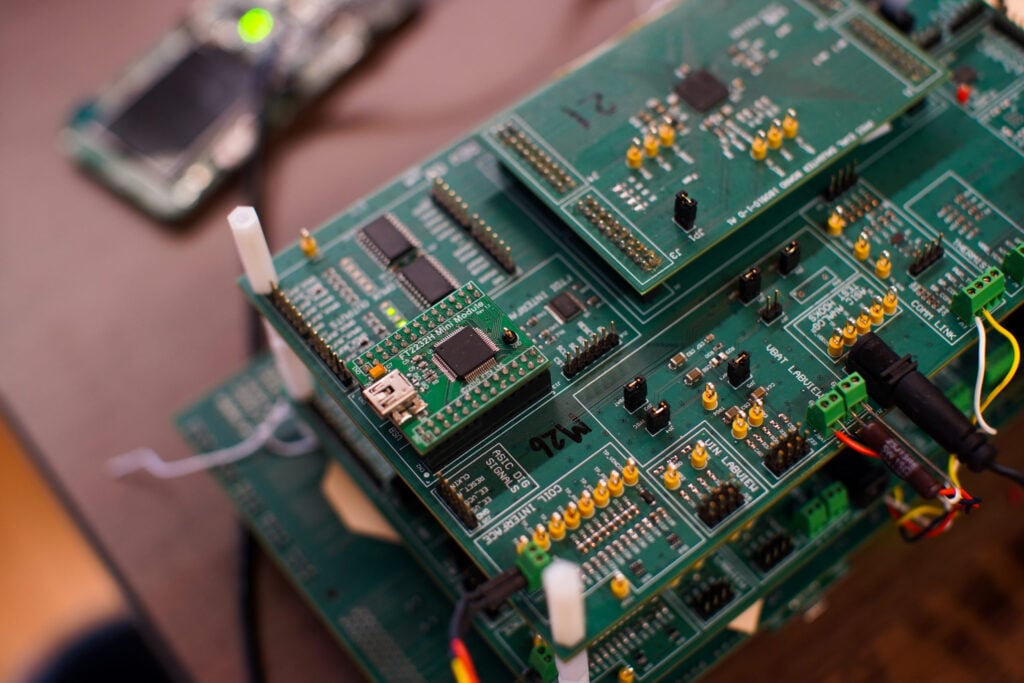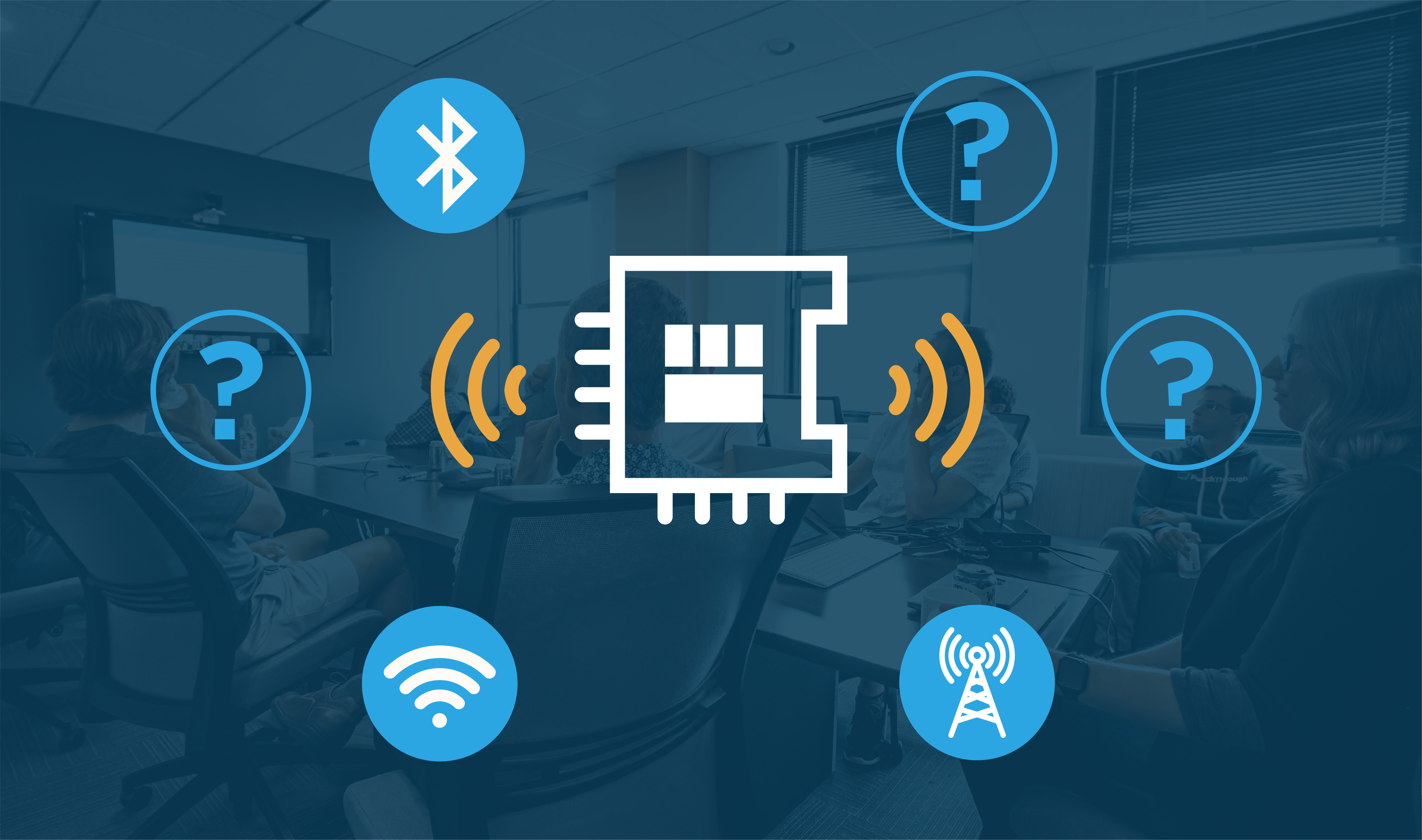When developing wireless products, one of the most important decisions engineers face is whether to use pre-certified radio modules or implement chip-down designs. This article guides you through the strategic considerations, economic factors, and technical challenges of each approach. You’ll learn when modules make sense for faster time-to-market, when to transition to chip-down designs for cost savings, and how to evaluate the ROI of making this transition.
Start with Pre-Certified Modules for Faster Market Entry
When developing the first generation of a new product, it’s often good practice to test the market with a device that costs less to design, even if it initially costs more to build. The goal is to get the device on the market sooner. If it takes off, then there will be justification for putting in the “Non-Recurring Engineering” (NRE) to cost-reduce the product for higher volume sales.
Key Benefit: Faster time-to-market with lower design costs
Pre-Certified Radio Modules Save Time and Certification Costs
When the new product includes wireless technology, it makes a lot of sense to start with a pre-certified radio module. The module manufacturer will have put in the time and expense of designing the module for common uses and will also need to get the module certified by the FCC and other regulatory bodies around the world. For the new product designer, these modules can typically be included in the custom product. The modular certifications can be applied to the new product, so the new product designer can skip the time and expense of going through most of the tests required to put a wireless device on the market.
Quick Win: Skip expensive and time-consuming certification tests
Real-World Example: Bluetooth Development
As an example, if you’re thinking about developing a Bluetooth-enabled device, there are many pre-certified Bluetooth modules on the market that are easy to connect into your client device. Some module manufacturers include a free BLE stack, SDK, and testing tools (thinking of Nordic Semiconductor, specifically) to enable the new product designer to quickly start writing the application firmware and communicating with a phone app. This can reduce new wireless product development cycles by months, and you can get your product on market much sooner.
When to Consider Chip-Down Design
If the market accepts the product, and you end up with “the good problem” of selling so many devices that it would be profitable to cost-reduce the product, then it’s a good time to consider moving from a modular design to a chip-down design.
Transitioning from Module to Chip
In fact, it’s fairly common for the wireless chip that’s at the heart of the BLE module to be available on the market as well. If you’ve initially researched the module to find out what “chip” is inside of the module, with some electrical design work, you can design that chip directly onto your main circuit board with a few support components — gaining identical performance and code-compatibility, while eliminating most of the BOM cost of the pre-certified module.
Certainly, doing a chip-down design takes some work and knowledge of good electrical and RF design practices. However, it’s also common for the chip manufacturer to provide chip-down design guidance, including good antenna design examples that will most-likely perform well and are intended to pass wireless certifications.
Module vs Chip-Down — Factors To Consider
Return on Investment
In addition to the costs of engineering and manufacturing efforts to convert to the new design, there’s also the cost and risk of EMC (Electro-magnetic Compliance) lab testing. A certified test lab will provide a quote for the testing and filings needed. A ballpark cost for this testing and filings will be roughly $20,000 for US (FCC) and Canada (ISED).
All other things being equal in the product design, the cost savings by converting from a module (~$6) to a chip-down ($2) with trace antenna, could be around $4 per unit. If the volumes are high enough, the NRE and certifications can be paid back in a year or two.
The Numbers:
- Potential savings: ~$4 per unit
- Module cost: ~$6 per unit
- Chip-down cost: ~$2 per unit
Volume Thresholds for Chip-Down Economics
A shipping quantity of about 10,000 units annually is roughly the threshold where going “chip-down” starts to make sense, and it’s a “no-brainer” at volumes of 25k or more.
Rules of Thumb:
- Under 10,000 units/year: Stick with modules
- 10,000-25,000 units/year: Consider chip-down
- Over 25,000 units/year: Definitely go chip-down
Time & Cost Comparison
The time it takes to do the electrical and RF design changes and testing, plus agency submittals is roughly 3 to 4 months, so the labor cost would be roughly $50,000 if everything goes per plan, and maybe $70,000 if there are some initial failures in testing.
In comparison, the time to create a design using a pre-certified module in the first place (just for integrating the RF module, assuming nearly identical firmware), will be 4 to 8 weeks of design work and about $3,000 of FCC/ISED testing. In total, the design cycle will probably take about 4 months.
ROI Summary
Altogether, for under $100,000 and 4 months of work, a savings of about $4 per unit can be realized for a BLE device by converting from a certified module to a chip-down design. As such, the costs can be made up by sales of about 25,000 units. If the sales volume is higher than 10,000 units per year, the ROI period can be about 2.5 years. Of course, all these numbers depend on many factors, but this is a good general guideline.
Part Sourcing & Product Life
One motivating factor in converting to a chip-down design is that with a certified module, your product is tied to the manufacturer of that module. A safer approach is to tie your product to the chip inside of the module since the chip manufacturer is producing many orders of magnitude more chips than the number of modules being produced using that chip. The RF chip manufacturers will also often guarantee production and support for the chip for a decade or more — something worth verifying with chip manufacturers.
Supply Chain Tip: Chip manufacturers typically offer longer product lifecycles than module manufacturers
Your Engineering Capabilities
I’ve heard it said that wireless technology development is like “black magic” and risky to get into. Using a certified module does eliminate a lot of risk on the design and certification side, but if BOM cost is a major driver for your product, a chip-down design might be less risky than you think. For many years now, the RF chip manufacturers have been providing a large amount of reference design help (electronics and firmware) to reduce that risk for product companies so they will incorporate their chips into products. If you understand good engineering design principles, and you follow the design guidance from the chip manufacturer, there’s a very good chance your product will slide through certification testing and approvals.
Antenna Considerations for Chip-Down Design
A certified module will include an integrated antenna and/or a connector for an external antenna. When doing a chip-down design, antenna considerations are a very important part of the redesign effort. What are the chances that an engineer who isn’t familiar with antenna design will be able to create a custom antenna design that works well?
Manufacturer Support for Antenna Design
It turns out that RF chip manufacturers will often provide reference designs for a few different types of Bluetooth (2.4 GHz) antennas that can be as simple as a copper shape/trace on the circuit board, plus a few matching components. This makes the antenna design process a lot easier, and the cost of the antenna is almost free – just the cost of some extra circuit board area which was probably already occupied by the previous RF module itself.
Antenna Options:
- Trace antenna on PCB (nearly free)
- Chip antennas (small, good performance)
- External antennas (best performance)
Alternative Antenna Options
If other types of antennas are required, there are many other types of antenna components available, and the manufacturers of those antenna parts generally provide support for design and testing. It’s never been easier to do your own RF designs if you have the margin in your budget and schedule for some on-the-job learning.
External Antenna Simplifications
Finally, if the original module only uses an external antenna, things tend to be even easier in the chip-down design since an on-board antenna is not needed. However, good RF design practices, including designing a proper transmission line to the antenna connector, are still required. There are free tools available online to help with calculating and designing controlled-impedance transmission lines as well.
Software Considerations: Bluetooth Stack and Tools
Some manufacturers give away their Bluetooth stack and even an SDK to get development underway with minimal work. Some sell a license or charge royalties. If your goal is to start with a module and migrate to a chip-down in the future, it’s wise to research the chips in the modules to see how the chip manufacturer deals with this issue and what tools they offer for development purposes. Costs for tools and licensing can still be small compared to the cost savings of doing the chip-down design. You will need to compare the “free” and “non-free” stack and tools costs, support, and features to see which chips are the best choice for your design.
Pro Tip: Research the software ecosystem before choosing modules to ensure a smooth transition path to chip-down later
Risk Factors: What Could Go Wrong?
I don’t need to tell a seasoned hardware engineer that getting through EMC testing is usually a bit of work and carries some risk for any new electronic product. Getting through EMC testing is often the last thing considered in the product development process and can be stressful for the uninitiated. There’s no substitute for experience in designing a product, especially a wireless product, so that it will pass EMC/RF testing without major problems. Your product, even without the radio, might have a noisy power supply or LCD data lines – among a host of other challenges. Adding a radio to that mix can compound and emphasize any EMC problems that product already has. Nonetheless, if your design has already passed EMC testing with a certified module, the chip-down design is relatively low-risk as long as you follow the RF chip manufacturer’s guidance carefully.
Plan for Iteration
Finally, when doing an RF design, it is wise to budget for a “second spin” of the board (and hopefully only a second spin). Nailing it on the first try is possible, but should not be assumed.
Budget Realistically:
- Allow extra time for regulatory submittals
- Include time for at least one board revision
- Plan for potential EMC test failures
Conclusion: Time to Make a Choice!
Many wireless chip manufacturers have helped to lower the barrier of entry to integrate their chips into host products. The costs and risks of converting from a pre-certified module to a chip-down design have been reduced over the past decade. If your company is already shipping a product that contains a certified wireless module, and your sales volumes are high enough that saving a few dollars per unit would be a big deal, then it might make sense to consider converting your product to a “chip-down” radio design.




